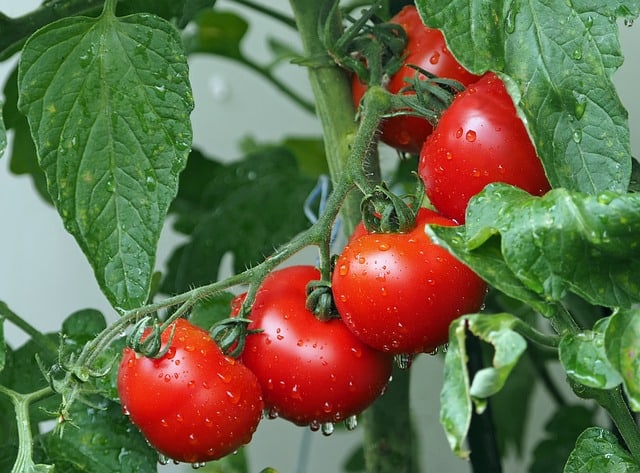White spots on tomato leaves can be a common issue for gardeners, and can be caused by a variety of factors. These spots can appear as small speckles or larger patches, and may be white, yellow, or brown in color.
While they may not always be harmful to the plant, it is important to identify the cause of the spots in order to prevent further damage.
Recognizing white spots on my tomato leaves is the first step in addressing the issue. These spots may be caused by fungal or bacterial infections, insect infestations, or environmental factors such as sunscald or nutrient deficiencies.
In some cases, the spots may be harmless and not require treatment, while in others they may indicate a more serious problem that needs to be addressed immediately.
Common causes of white spots on tomato leaves include powdery mildew, which is a fungal infection that thrives in warm, humid conditions, and can spread quickly through a garden.
Other fungal infections, such as early or late blight, can also cause white spots on leaves and may require treatment with fungicides. Insect infestations, such as spider mites or aphids, can also cause white spots on leaves, as can environmental factors such as sunscald or nutrient deficiencies.
Also don’t miss:
Recognizing White Spots on Tomato Leaves
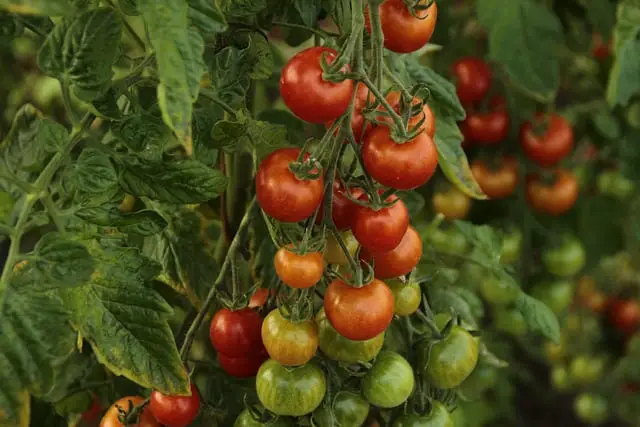
White spots on tomato leaves can be an indication of a variety of problems that may be affecting the health of the plant. It is important to recognize these spots early before they develop into a more severe issue that can lead to the death of the plant. Here are some common causes of white spots on tomato leaves:
1. Powdery Mildew
One of the most common causes of white spots on tomato leaves is powdery mildew. This fungal disease appears as a white, powdery substance on the leaves and stems of the plant. It can be spread by air currents, insects, and contaminated tools. If left untreated, powdery mildew can cause the leaves to yellow and die.
2. Bacterial Spot
Another common cause of white spots on tomato leaves is bacterial spot. This disease is caused by a bacterium that can be spread by rain, irrigation, or contaminated tools. The spots are usually small and circular, with a yellow halo around them. As the disease progresses, the spots may turn brown and cause the leaves to drop off.
3. Sunscald
Sunscald is a common problem that can cause white spots on tomato leaves. This occurs when the plant is exposed to too much direct sunlight, causing the leaves to become discolored and develop white spots. This can be prevented by providing shade for the plant during the hottest part of the day.
4. Insect Infestation
Insect infestations can also cause white spots on tomato leaves. Common pests such as aphids, whiteflies, and spider mites can damage the leaves and cause them to develop white spots. It is important to identify and treat the infestation early to prevent further damage to the plant.
5. Mineral Deficiencies
White spots on tomato leaves can also be caused by mineral deficiencies. A lack of calcium, magnesium, or other essential nutrients can cause the leaves to develop white spots. This can be prevented by providing the plant with a balanced fertilizer and ensuring that the soil is properly amended.
White Spots on My Tomato Leaves – 4 Common Problems
Tomato plants are susceptible to various problems that can cause white spots on their leaves. This section will explore some of the most common causes of white spots on tomato leaves.
1. Fungal Diseases
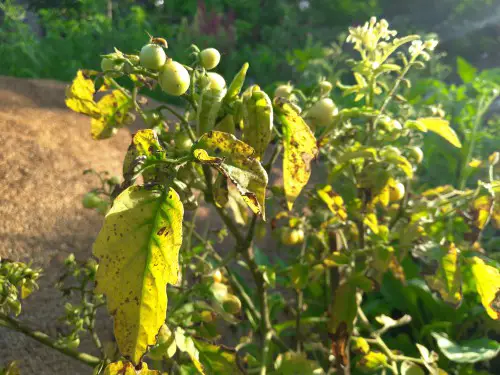
Fungal diseases are one of the most common causes of white spots on tomato leaves. Some of the most common fungal diseases that can cause white spots on tomato leaves include late blight, septoria leaf spot, and powdery mildew.
These fungi can be carried by air currents and insects such as aphids, whiteflies, and mealybugs.
Late blight is a devastating disease that can cause white spots on tomato leaves. It can spread rapidly, causing the plant to wilt and die. Septoria leaf spot is another common fungal disease that can cause white spots on tomato leaves. It can cause the leaves to turn yellow and fall off, leading to reduced yield.
Powdery mildew is a fungal disease that can cause white spots on tomato leaves. It is not easy to avoid as it can be carried by air currents and insects.
A powdery mildew infection doesn’t really damage the plant that much, but it will lead to a lower yield, change the taste of your tomatoes for the worse, and lead to stunted growth of the entire plant.
2. Insect Damage
Insect damage is another common cause of white spots on tomato leaves. Insects such as aphids, whiteflies, and mealybugs can cause white spots on tomato leaves by feeding on the plant’s sap. The damage caused by these insects can lead to a reduced yield and stunted growth of the plant.
3. Sun Scalding
Sun scalding is another common cause of white spots on tomato leaves. This occurs when the leaves are exposed to too much direct sunlight. The leaves will turn white and then brown, eventually dying off. This can be prevented by providing the plant with some shade during the hottest part of the day.
4. Nutrient Deficiency
Nutrient deficiency can also cause white spots on tomato leaves. A lack of nitrogen can cause the leaves to turn yellow and develop white spots. Fertilization can help prevent this from happening.
Effects on Tomato Plants and Fruit
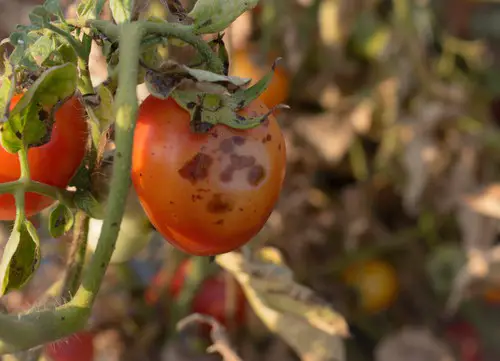
White spots on tomato leaves can have a significant impact on the health and growth of tomato plants, as well as the quality and yield of the fruit they produce. Here are some of the effects that these spots can have:
- Reduced Growth: When tomato plants are affected by white spots, their growth can be stunted. This can result in smaller plants with fewer leaves, which can make it harder for them to produce fruit.
- Reduced Yield: White spots on tomato plants can also lead to a reduction in the number of fruits they produce. This can be due to a variety of factors, including a lack of nutrients, reduced photosynthesis, and damage to the plant’s vascular system.
- Poor Quality Fruit: In addition to reducing the quantity of fruit, white spots can also impact the quality of the fruit that tomato plants produce. This can include splotches or blistery areas on the surface of the fruit, which can make them less appealing to consumers.
- Altered Taste: The presence of white spots on tomato plants can also affect the taste of the fruit they produce. In some cases, the fruit may taste bitter or have a strange aftertaste due to the presence of toxins produced by the fungus or bacteria causing the spots.
To prevent these negative effects, it’s important to take steps to identify and treat white spots on tomato plants as soon as possible. This can include removing infected leaves, improving air circulation around the plants, and using fungicides or other treatments to kill the pathogens causing the spots.
By taking these steps, gardeners can help ensure that their tomato plants grow healthy and produce high-quality fruit.
Prevention Strategies
Preventing white spots on tomato leaves is crucial to ensure a healthy and productive harvest. Proper care and maintenance can help prevent the growth of powdery mildew, the main culprit behind white spots on tomato leaves. Here are some effective prevention strategies:
1. Proper Watering and Humidity Control

Tomatoes require adequate moisture levels to thrive, but overwatering can lead to high humidity levels, which can encourage the growth of powdery mildew. To prevent this, it is recommended to water the soil around the plant and avoid getting the leaves wet.
A drip irrigation system is ideal for growing tomatoes, as it delivers water directly to the soil without wetting the leaves.
2. Pruning and Increasing Air Circulation
Pruning your tomato plant encourages growth, but it can also be used as a treatment against powdery mildew. Pruning the infected leaves will prevent the powdery mildew from spreading to other parts of the plant. It will also improve air circulation and help prevent the growth of powdery mildew in the future.
3. Using Resistant Varieties
Certain tomato varieties are more resistant to powdery mildew than others. When selecting tomato seeds, look for varieties that are labeled as resistant to powdery mildew. These varieties are less likely to develop white spots on their leaves, even under high humidity conditions.
4. Proper Spacing and Transplanting
Tomato plants need adequate space to grow and thrive. Planting tomato plants too close together can lead to high humidity levels and the growth of powdery mildew. It is recommended to plant tomato plants 18-24 inches apart for the best results.
Proper transplanting techniques can also help prevent the growth of powdery mildew. When transplanting young tomato seedlings, it is important to be attentive to their care, provide adequate watering, proper sunlight, shed and wind conditions, and careful use of fertilizers and fungicides.
By following these prevention strategies, gardeners can enjoy a healthy and productive tomato harvest without the unsightly white spots on their leaves.
Treatment Methods for White Spots
White spots on tomato leaves can be a sign of a fungal infection or pest infestation. Treatment methods vary depending on the cause of the issue. Here are some effective treatment methods to consider:
1. Using Fungicides
Fungicides are chemical sprays that can be used to treat fungal infections. They work by killing the fungi that cause the white spots on tomato leaves. It is important to choose a fungicide that is labeled for use on tomatoes and follow the instructions carefully.
Some common fungicides used to treat white spots on tomato leaves include copper-based fungicides, sulfur-based fungicides, and chlorothalonil-based fungicides.
2. Neem Oil and Other Organic Solutions
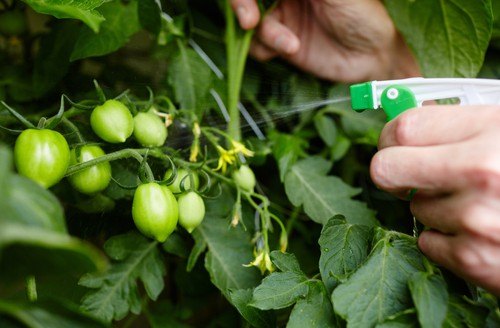
Neem oil is a natural fungicide that can be used to treat white spots on tomato leaves. It works by disrupting the life cycle of the fungi that cause the white spots. To use neem oil, mix it with water according to the instructions on the label and spray it on the affected plants.
Other organic solutions that can be used to treat white spots on tomato leaves include baking soda, milk, and garlic.
3. Insecticides for Pest Control
White spots on tomato leaves can also be caused by pest infestations. Insecticides can be used to control the pests that cause the white spots. It is important to choose an insecticide that is labeled for use on tomatoes and follow the instructions carefully.
Some common insecticides used to control pests on tomato plants include pyrethrin-based insecticides, spinosad-based insecticides, and neem oil-based insecticides.
It is important to note that prevention is key when it comes to white spots on tomato leaves. Proper care and maintenance of tomato plants can help prevent fungal infections and pest infestations. This includes regular pruning, proper watering, and fertilization.
If white spots do appear on tomato leaves, it is important to identify the cause and choose the appropriate treatment method for the best results.
Post-Treatment Care and Maintenance
After treating white spots on tomato leaves, it’s important to take care of the plant to prevent the problem from recurring. Here are some post-treatment care and maintenance tips:
1. Watering
Proper watering is essential for healthy tomato plants. Over-watering or under-watering can cause stress to the plant and make it more susceptible to diseases. Water the plant deeply and regularly, but avoid getting the leaves wet. Use a soaker hose or drip irrigation system to deliver water directly to the soil.
2. Fertilize
Tomato plants need regular feeding to produce healthy fruits. Use a balanced fertilizer with equal amounts of nitrogen, phosphorus, and potassium. Apply the fertilizer according to the manufacturer’s instructions, and avoid over-fertilizing, which can lead to nutrient burn.
3. Sanitize
To prevent the spread of disease, sanitize your gardening tools and equipment after each use. Use a solution of one part bleach to nine parts water to disinfect pruning shears, stakes, and other tools.
4. Compost
Adding compost to the soil can improve its structure and fertility. Compost also contains beneficial microorganisms that can help prevent disease. Apply a layer of compost around the base of the plant, but avoid getting it on the leaves.
5. Temperature
Tomato plants thrive in warm temperatures, but they can be stressed by extreme heat or cold. Provide shade during the hottest part of the day with a shade cloth or by planting the tomatoes near a taller plant that casts a shadow.
6. Lighting
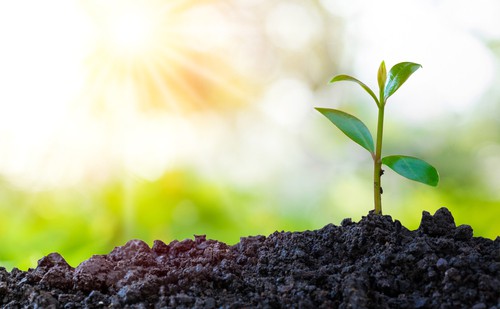
Tomato plants need at least six hours of direct sunlight each day to produce fruit. If your garden doesn’t get enough sunlight, consider growing tomatoes in containers that can be moved to a sunnier location.
By following these post-treatment care and maintenance tips, gardeners can help their tomato plants recover from white spots on the leaves and prevent future problems.
Conclusion
White spots on tomato leaves can be caused by a variety of factors, including powdery mildew, sunburn, lack of nutrients, and sudden changes in conditions during transplant. It is essential to identify the underlying cause of the white spots to determine the appropriate treatment.
One effective way to prevent white spots on tomato leaves is to ensure that the plants are receiving adequate nutrients, particularly calcium. Calcium deficiency is a common cause of white spots on tomato leaves. Adding calcium to the soil or using a calcium-rich fertilizer can help prevent this problem.
Powdery mildew is another common cause of white spots on tomato leaves. This fungal disease is characterized by a white, powdery coating on the leaves. To prevent powdery mildew, it is essential to maintain good air circulation around the plants and avoid overhead watering.
Pruning infected leaves can also help prevent the disease from spreading.
In some cases, white spots on tomato leaves may be a sign of a more serious problem, such as late blight. This fungal disease can quickly destroy a tomato crop, so it is important to identify and treat it as soon as possible.
Symptoms of late blight include dark spots on the leaves and a foul odor. If you suspect that your tomato plants have late blight, it is best to remove them from the garden and dispose of them immediately to prevent the disease from spreading to other plants.
Frequently Asked Questions
What causes white spots to appear on tomato leaves?
White spots on tomato leaves can be caused by several factors, including powdery mildew, sunscald, and late blight. Powdery mildew is a fungal disease that can easily spread through air currents and insects such as aphids.
Sunscald occurs when the tomato plant is exposed to too much direct sunlight, causing the leaves to develop white or yellow spots. Late blight is a bacterial disease that can cause the leaves to develop white spots, which eventually turn brown and cause the plant to die.
How can I get rid of white spots on my tomato leaves?
The best way to get rid of white spots on tomato leaves depends on the cause of the problem. For powdery mildew, pruning the infected leaves can help prevent the disease from spreading to other parts of the plant.
Fungicides can also be used to treat powdery mildew. For sunscald, providing shade to the plant during the hottest parts of the day can help prevent further damage. For late blight, removing infected leaves and using fungicides can help prevent the disease from spreading.
Is it harmful to eat tomatoes with white spots on the leaves?
White spots on tomato leaves are not harmful to eat. However, if the spots are caused by a fungal or bacterial disease, the plant may be weakened and produce less fruit. It is important to properly wash and inspect all tomatoes before consuming them.
How do I prevent white spots from forming on my tomato leaves?
Proper care and ideal growing conditions can help prevent white spots from forming on tomato leaves. This includes providing adequate water and nutrients, ensuring proper air circulation, and providing shade during the hottest parts of the day.
Regularly inspecting the plant for signs of disease and promptly treating any issues can also help prevent white spots from forming.
Are white spots on tomato leaves a sign of disease?
Yes, white spots on tomato leaves can be a sign of disease. Powdery mildew, sunscald, and late blight are all common diseases that can cause white spots to form on tomato leaves.
It is important to properly identify the cause of the white spots and treat the issue promptly to prevent further damage to the plant.
Can vinegar be used to treat white spots on tomato leaves?
While vinegar can be used as a natural fungicide, it is not recommended for treating white spots on tomato leaves. Vinegar can damage the leaves and may not effectively treat the underlying issue causing the white spots.
It is best to use a fungicide specifically designed for the type of disease affecting the plant.

Hey, I’m Lisa and I’ve been an avid gardener for over 30 years. I love writing, talking and living in the garden! Feel free to connect with me on my socials below

